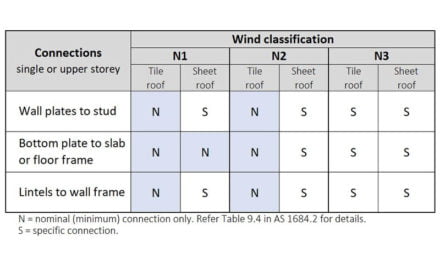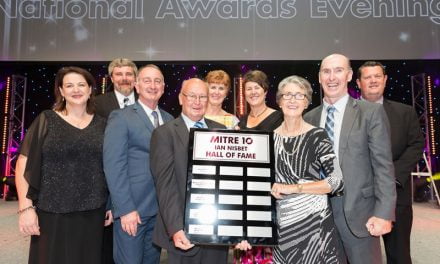Understand the true risk of new products as the laws demand strict compliance and ignorance is no excuse. By Craig Kay, national product engineer, Tilling
Anthony Michael Fadell (born 22 March, 1969) is an American engineer, innovator, designer, entrepreneur, founder, coach and active investor. He is the inventor of the iPod, co-inventor of the iPhone, and founder and former CEO of Nest Labs. One of his quotes is very applicable in the current timber supply environment: “Even if you have constrained resources, don’t cut corners. People will feel it.”
Timber distribution companies generate profits only when they sell large volumes of product, so the product manager’s/engineer’s role within the company is often semi-humorously referred to as the ‘sales prevention officer’ or something similar.
We are the ones who seemingly complicate things by insisting on taking the time to carry out a due diligence process on every structural product to ensure that it meets the requirements of the relevant standard before being offered for sale.
This insistence on keeping the due diligence process robust in this time of timber shortages can be viewed in two opposing ways:
- It’s an impediment to rapidly bringing new previously unknown manufacturers product to market quickly;
OR
- It’s what distinguishes a legitimate and responsible timber trader from a broker who thinks that he can simply import structural timber product on the open market and distribute it with little supporting evidence that it meets the applicable standard and is thus fit for purpose.
LVL and wood I-Joists are proprietary products and there are no ‘standard’ grades of either in Australia. There are no generic span tables in AS 1684 for LVL, wood I-Joists or glue-laminated timber (GLT or glulam) although characteristic strengths for standard grades of GLT are listed in AS 1720.1. The only span tables/installation guides available for these products are proprietary, and only represent their respective products’ unique characteristic strength values.
Span tables are an engineering calculation carried out under the control of a Professional Engineer, a defined term within schedule 3 of the National Construction Code (NCC), which mandates the necessary qualifications and experience required for that position.
In at least two Australian states, there is specific legislation requiring the registration of professional engineers, with other states having Building Practitioner regulations which also include engineers. A mandatory requirement for a registered engineer under state regulations is to demonstrate that they hold the prescribed level of Professional Indemnity (PI) insurance. This PI insurance is quite clearly primarily aimed at protecting the consumer against errors in the service provided by the engineer.
As I have occasionally been correctly reminded by my employer over the years, while necessary to the company, engineers are an expensive overhead for the distribution company.
At this point you may be wondering where I am heading with this, and why is it relevant?
Currently with a shortage of EWP, a number of new players are promoting previously unseen LVL with a grade stamp stating an ‘E’ value, as if that E value fits the product into some standard grade. The only documentation is a glossy flier containing some product information and pictures, but typically little more. There are no standard grades for LVL so the product, unless designed by an engineer for its specific characteristic properties, cannot legally be designed by a potential user referencing span tables from another manufacturer’s LVL, even if the products appear similar.
The 1986 Castrol advertisement “Oils ain’t oils” could be modified currently into “LVLs ain’t LVLs”.
In 2010, the Trade Practices Act 1974 was replaced by the Competition and Consumer Act 2010 and is enforced by the Australian Competition and Consumer Commission (ACCC). There are some key parts of this legislation in Schedule 2 that relate to the supply of LVL in the Australian market:
Chapter 1 – 7 – Meaning of manufacturer – in essence, the importer is deemed the manufacturer, so the importer cannot pass off any responsibility to some overseas entity if problems arise.
Chapter 3 Part 3.1 Division 1- 29 – False or misleading representations about goods and services. Subsection (1) – make a false or misleading representation that goods are of a particular standard, quality, value, grade, competition style or …
Chapter 3 Part 3.1 Division 1- 33 – Misleading conduct as to the nature etc of goods a person must not, in trade or commerce, engage in contact conduct that is liable to mislead the public as to the nature, the manufacturing process, the characteristics, the suitability of their purpose or quality of any goods.
These clauses are front and centre in the mind of any product manager who is assigned the task to manage product risk for the enterprise, and have been the cause of many sleepless nights, for me at least.
Timber standards require that any product claiming conformance to that standard is marked in a prescribed manner. The stamping of a respective standard on the piece of timber has in essence, the same effect as preparing a statutory declaration that each piece of timber meets ALL the provisions of that standard.
It is common for new manufacturers to the Australian market to claim that they have carried out a number of qualification tests, but it is important to realise that compliance to AS/ZS 4357 (LVL) is so much more than simply testing 30 pieces at the start of the programme. Conformance to the standard involves continuous production testing to guarantee that what is being produced each day matches the initial test results. A document from a hitherto unknown testing facility with a series of test results for 30 samples in conformance with AS/NZS 4357 for a product, does not automatically justify a product being stamped as being in conformance with the standard. Are we simply getting a bunch of one-off test results which reflect a snapshot in time, or is a JAS-ANZ accredited assessment body certifying that the production process is in conformance with the standard?
For our Queensland readers, there is another Queensland specific Act which attributes a duty of care upon each and every person, from the supplier, to the draughtsperson to the builder to ensure that the product being used is in conformance with the relevant standard. The Building and Construction legislation (Non-conforming Building Products—Chain of Responsibility and Other Matters) 2017. Subdivision 2 states:
Clause 74AE
A person is a person in the chain of responsibility for a building product if—
(a) the person—
(i) designs, manufactures, imports or supplies the building product; and
(ii) knows, or is reasonably expected to know, the product will or is likely to be associated with a building; or
(b) the person installs the product in a building in connection with relevant work.
Clause 74AF
Each person in the chain of responsibility for a building product must, so far as reasonably practicable, ensure that the product is not a non-conforming building product for an intended use.
Clause 74AG
(1) A person in the chain of responsibility for a building product who designs the product must ensure, so far as reasonably practicable, that, if the person gives the design to another person who is to give effect to the design, the design is accompanied by the required information for the product.
(2) A person in the chain of responsibility for a building product who manufactures, imports or supplies the product must ensure, so far as reasonably practicable, that when the person gives the product to another person the product is accompanied by the required information for the product.
The Required information, for a building product, means information about the product that—
(a) for each intended use of the product, states or otherwise communicates the following—
(i) the suitability of the product for the intended use and, if the product is suitable for the intended use only in particular circumstances or subject to particular conditions, the particular circumstances or conditions;
(ii) instructions about how the product must be associated with a building to ensure it is not a non-conforming building product for the intended use;
(iii) instructions about how the product must be used to ensure it is not a non-conforming building product for the intended use; and
(b) complies with the requirements for the information, if any, prescribed by regulation for this definition.
For those who understandably simply skipped over the legal speak in the legislation, this is a precis of the Qld legislation:
- Everybody who supplies, designs or constructs with a product, so far as reasonably practicable, is responsible for the product quality and suitability.
- It is incumbent upon the supplier to provide sufficient information about the suitability of the product for its intended uses and equally, where not to use it.
Conclusion
For our Queensland merchant friends, not only could you be held accountable under the Competition and Consumer Act if a product you sell with unknown provenance ultimately does not perform as marked, but you also will need to demonstrate that you have performed sufficient due diligence concerning any product you sell, to be satisfied that it meets the Non-Conforming Building Products—Chain of Responsibility and Other Matters Act 2017. That far reaching Act makes everybody who has anything to do with the product, from supply, design, to construction, ultimately accountable.
For states other than Queensland, you still have that state’s Construction Code Authority (CCA) to deal with. They are empowered to issue infringement notices and apply penalties, which are in many cases published online. The ACCC Infringement notices at www.accc.gov.au/public-registers/infringement-notices also make for interesting reading.
The takeaway questions for any person in both the supply chain, and building profession are:
- Does your EWP supplier have professional staff who have completed, and can demonstrate their completed due diligence as required by legislation on every structural product they market
- Does your EWP supplier provide span table, comprehensive Design Guide and technical support for their product, i.e. the Required information?
If not, “Even if you have constrained resources, don’t cut corners. People will feel it” may prove prophetic in your circumstance.
For more information on this topic, contact Craig Kay and the Tilling engineers via email at techsupport@tilling.com.au











